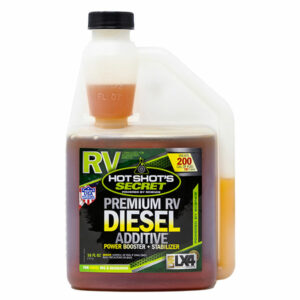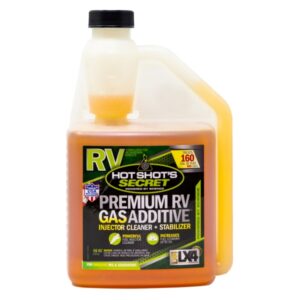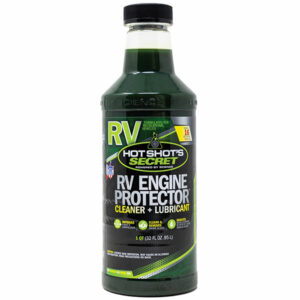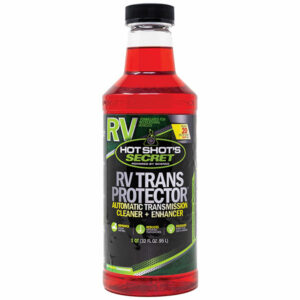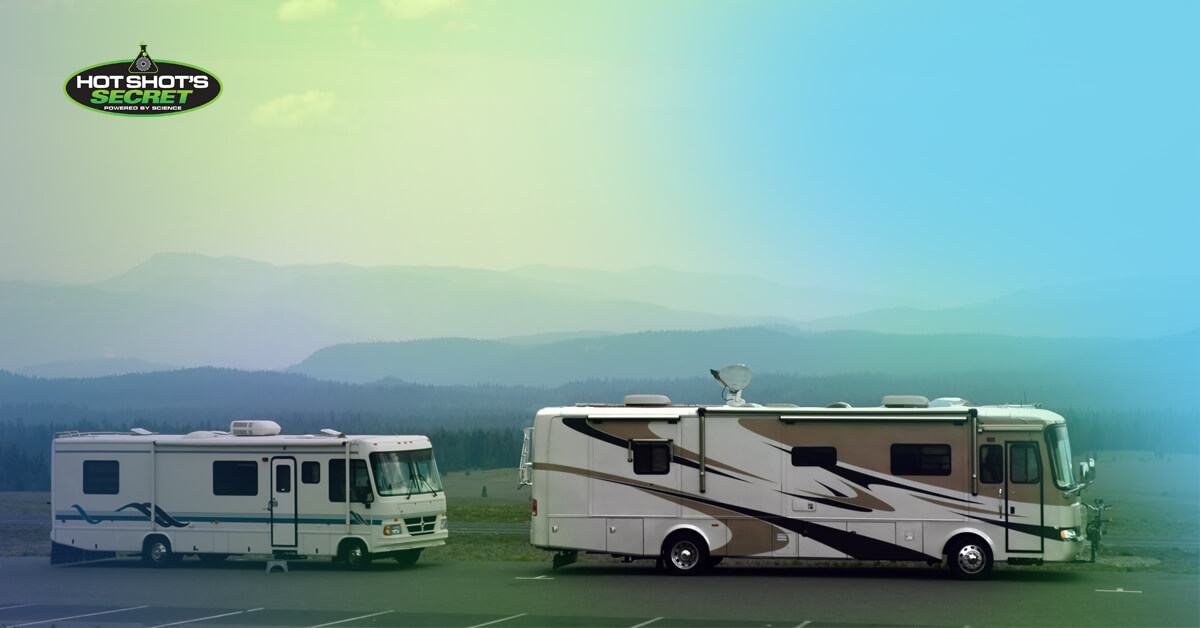
Lots of Miles, Followed by Lots of Downtime: Tips to Take Advantage of Both
When passion and pocketbook seem to work in tandem, not only does one help the other but an attentive audience can also learn straight from the source. For the Recreation Vehicle enthusiast, today’s source is not only a veteran of the common past time, but also a veteran of science and technology, directly helping RVs stay on the road and better ensuring his fellow RV’er, remain a happy camper!
Chris Gabrelcik, President of Lubrication Specialties, Inc. (LSI), is one of the few people worldwide to hold certifications of Lubrication Specialist (CLS) and Oil Management Analysis (OMA). He has built his company and his Hot Shot’s Secret product line around his and his team’s scientific expertise with a goal to keep vehicles on the road with less breakdowns, more efficiency and especially in his own case, to keep his RV in tip-top condition for all of his past, present and future jaunts across the United States interstate system.
Gabrelcik has been an avid camper from the days when he first met his wife and able to only afford a tent, to supporting a growing family on the road with him as he traveled for his job, to current-day outings in his coach. “RV’ing is the opportunity to get away from city life and exit the pressures of our daily concerns,” says Chris. “It’s is an economical way to escape the grind, seize the chance to relax, sit by a campfire and get to know a ton of other like-minded folks. We all like to walk around the campsites, talk about the different rigs, share our favorite experiences and further build the camping community.” Chris notes that the camping enthusiasts typically share the common sense of camaraderie regardless of what kind of rig is used to get them there. “There are people at the campsites in $500,000 rigs and there are people there in pop-up campers. And everyone is there for all the same reasons, we love camping. It’s always like you’re there with your next door neighbor.”
Chris has traversed the country experiencing almost everything while camping or cruising in an RV. “If it can happen, we have experienced it, good, bad and ugly,” says Chris. “We started in a little pop up camper, then a pull-behind camper.” The Gabrelcik’s continued their graduation with expansions to a Class B RV, Class C, then a couple Class A Gas RVs. Chris now pilots the 40’ diesel pusher with slides and two bathrooms. “We are on our 10th rig, and making plans to head (from Ohio) to the Pacific Northwest.” Among others in their past, the G’Family excursions include trips to San Diego, annual trips to Florida, Texas, Maine, Vermont, North Carolina and the list goes on. “We’ve been RV’ing for 30 years with a lot of trips under our belt. I could write a book on RV’ing!” chuckles Chris.
COMMON MAINTENANCE:
Most RV’s rarely surpass 100,000 on the odometer. Therefore, maintenance is a crucial need to reach the century-mark milestone as well as keep the big camper on the road. “So many of these RV’s are not made as performance machines,” says Gabrelcik. “The manufacturers are building a house on top of a chassis, and all of the R&D goes into the box on top of it. The focus is in the camper; the beds, the kitchens, the tile, finishes, etc. Not a lot goes into mechanical performance enhancements.”
To help however, Chris offers a few items requiring mechanical focus, to make sure the beds, the kitchens, the tile, finishes, etc. can successfully stay on the road.
Resilience of your tires: Tires include a date-stamp because ozone and sunshine can wreak havoc on tires and they become dry-rotted. Without good rubber on the road, the chances of a blow out increase, “and that’s a disaster,” says Chris. “I’ve been there and learned that lesson the hard way.”
Resilience of your belts: Similar to rotting tires, the engine belts tend to rot when idle as well. The engine may have only 15,000 miles on it but the belts may be 20 years old. Always check for cracks, frays and pliability in your belts. Older rotting belts should be replaced before any road trip.
Age of your oil: People mostly consider the mileage on their RVs and the components used within, but Chris notes, “with RV’s they will sit idle for longer periods. There may only be only 1000 miles on the current oil in the engine, but it’s been in there for three years.” When oil sits over an extended period of time, acid builds up and weakens the lubricity, causing unneeded wear and tear when the engine restarts. While sitting the acid also eats away at the surrounding metals and gaskets. Consider oil changes against a measurement of time as well as mileage.
Age of your fuel: Old gasoline and diesel fuel become ‘varnishy’ leaving deposits throughout the fuel system. Fuel additives can help with deep-clean and daily usage to not only help clean the aging fuel residue and in the case of diesel fuel also provide a higher cetane rating so the old fuel actually burns cleaner and more efficiently when restarting after sitting idle.
Take advantage of Additives: “Run a heavy duty cleaner through the fuel system at minimum, annually. “This isn’t the time for the $2.99 bottle on the shelf,” says Chris. “When running a cleaner additive, use an industrial strength cleaner that you know will provide the benefits promised, making sure your engine remains in its best condition.
The proper line of additive products supports the common issues specific to the RV and its use.
PREVENT DISASTERS:
The worst thing that can happen to a truck driver, an RV’er or anyone traveling is to breakdown. “Beyond the obvious inconvenience and being stuck on the road,” says Chris, “you become at the mercy of everyone else during a breakdown. If my rig breaks down in California, and I have to go back home to Ohio, while they are working on it, I’m unable to monitor any work done on my rig. Plus, when the repairs are inaccurate, it’s not at all feasible to take my rig back to California for them to correct their errors. Or if staying with the rig, then you’re held up in a hotel, while the RV (your home) is in the shop. The time to avoid a breakdown is at home before you ever leave for the trip.
With so many online forums available it’s easy to see multitudes of stories where someone didn’t take the proper care of their RV before, during and after the trip. Just as a pain-free RV get away can be such a pleasure, without proper care and attention to any mechanical vehicle, quite the opposite extreme is possible (probable) as well when leaving it to chance. So…
Check Your Tire Pressure: RVs and other bigger rigs on the road are designed so that the weight of the vehicle and the torque between the wheel and road are distributed across multiple axles and tires. Should one of the tires be off spec, and not able to handle the distribution designed, the entire vehicle becomes a risk. Chris says, “When a wheel has to carry more weight because of another weakened tire in the vehicle, the extra burden causes extra heat, and the steel belts in the tire begin to separate, and cause blow-outs. With the added weight, the added distribution and the added distances traveled, the RV tire pressure is exponentially more vital than just the daily driver car in the garage.
Check the Electrical System: Again, these vehicles are not in use every day so issues can creep into a variety of systems. Campers and RVs often include multiple electrical supplies: 110v / 12v / and inverter systems must all be checked for proper amperage. Checking before you leave will save any unwarranted surprises when it comes time plug in any electrical device. Not to mention any possible fire hazards.
Check the Generator: Make sure just as the powertrain engine, that the generator also has been maintained and addressed for any new fluids and operating components. Make sure to change fluids and filters as recommended.
Change the Oil: Ensuring fresh oil and avoiding oil that has not broken down is imperative. Avoid a locked up motor, or a motor chewing itself up with non-lubricated parts continually grinding away. Oil additives can help enhance the source oils as well, providing a bonding agent and nano particle protection barrier for added lubricity across the oil-impacted components. Especially in diesel RV systems, the oil serves as not only lubricity in the main engine block itself, but some injectors may still be on the road reliant on oil pressure and lubricity within the higher tolerance fuel system.
Check the Roof: Whether a rubber, thermoplastic polyolefin, or fiberglass roof, Chris claims, “I have had them all leak. You have to ‘stay on top’ of it; especially the rubber roofs, the sun will rot them. I’ve redone roofs once I spent a week at a campsite with rainwater leaking in.
Make a Test Run: Before pulling out of the driveway for the long distance excursion, try a shorter version as a trial run. “Take the rig for a 100 mile trip, maybe around the city, or over to the next town first,” says the RV veteran. “If it’s been sitting for over three months, provide yourself a re-break-in for everything. 500 miles down the road is not the time to experiment. Put in your heavy-duty fuel additives for the fuel system deep clean, regardless of gas or diesel, and drive for a while. Take notice of your fuel economy as it could be an easy telltale sign that everything is running smooth, or not.
Whether the coast-to-coast thrill seeking geographic adventurer, or the weekend warrior at the local campground, your RV can make or break the ideal getaway trip. With some beneficial maintenance and preventive care however, a pain-free drive is far more probable with complete confidence in your rig. You’ll find it wise to invest a little extra time and money so that you don’t cheat yourself out of a fun trip!
TESTIMONIALS:
“We run Stiction Eliminator once a year, and we always use the Blue Diamond engine oil. The extra additive benefits included in the Blue Diamond synthetic engine oil, help protect our coach while it’s sitting 3 months at a time. While our additives help prevent the oil from any acid build up, the synthetic then helps improve fuel mileage.”
“We use Diesel Extreme and Everyday Diesel Treatment in the fuel system and we experience a full 10% increase in our RV mileage. As both a scientist and a consumer, I have consistently tested with and without the fuel additives and I consistently experience the same results. Gasoline Extreme is available for the same results in gas RVs.”
“We use the Shift Restore and we’ve noticed there is more power provided in the hills and shifting into 4th gear. We see a drastic increase in the efficiency of the transmission. For example, the gas RV’s often use a V10 and a 4-speed transmission that seems underpowered. If you get stuck behind a Class A RV, you’ll notice it doesn’t power up a hill. They are only going 35mph and the driver’s pedal is to the floor with the RPMs screaming. The Shift Restore makes a world of difference in 4 speeds and the big rigs. It’s a much more enjoyable driving experience with the transmission shifting smooth, gliding from gear to gear.”
“We continually take advantage of the Hot Shot’s Secret advanced lubrication and the additives, for much more enjoyable driving, performance and peace-of-mind. It’s a drastic difference, undeniable in the experience. If we took a road trip in one direction without Hot Shot’s Secret, then added the transmission, oil and fuel additives for the return trip, it would be night and day difference. You can literally tell the difference within just a few miles. You’d be stunned! It’s like replacing a V6 with a V8. Since these RVs are not really made to be a performance vehicle, the added boost is just that much more noticeable.”
“We know just from scientific studies with dynamometer and lab tests that we can increase horsepower performance by 5% to 8% just in standard big-rig applications. But it’s the overall driving experience of RV, Pro Coach and Big Rig drivers that can truly notice the improvements.”

